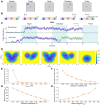Controlling brain dynamics: Landscape and transition path for working memory
- PMID: 37669311
- PMCID: PMC10503743
- DOI: 10.1371/journal.pcbi.1011446
Controlling brain dynamics: Landscape and transition path for working memory
Abstract
Understanding the underlying dynamical mechanisms of the brain and controlling it is a crucial issue in brain science. The energy landscape and transition path approach provides a possible route to address these challenges. Here, taking working memory as an example, we quantified its landscape based on a large-scale macaque model. The working memory function is governed by the change of landscape and brain-wide state switching in response to the task demands. The kinetic transition path reveals that information flow follows the direction of hierarchical structure. Importantly, we propose a landscape control approach to manipulate brain state transition by modulating external stimulation or inter-areal connectivity, demonstrating the crucial roles of associative areas, especially prefrontal and parietal cortical areas in working memory performance. Our findings provide new insights into the dynamical mechanism of cognitive function, and the landscape control approach helps to develop therapeutic strategies for brain disorders.
Copyright: © 2023 Ye et al. This is an open access article distributed under the terms of the Creative Commons Attribution License, which permits unrestricted use, distribution, and reproduction in any medium, provided the original author and source are credited.
Conflict of interest statement
The authors have declared that no competing interests exist.
Figures






Similar articles
-
Non-equilibrium landscape and flux reveal the stability-flexibility-energy tradeoff in working memory.PLoS Comput Biol. 2020 Oct 2;16(10):e1008209. doi: 10.1371/journal.pcbi.1008209. eCollection 2020 Oct. PLoS Comput Biol. 2020. PMID: 33006962 Free PMC article.
-
Working memory capacity of crows and monkeys arises from similar neuronal computations.Elife. 2021 Dec 3;10:e72783. doi: 10.7554/eLife.72783. Elife. 2021. PMID: 34859781 Free PMC article.
-
Quantifying the Landscape of Decision Making From Spiking Neural Networks.Front Comput Neurosci. 2021 Oct 28;15:740601. doi: 10.3389/fncom.2021.740601. eCollection 2021. Front Comput Neurosci. 2021. PMID: 34776914 Free PMC article.
-
Neural substrate and underlying mechanisms of working memory: insights from brain stimulation studies.J Neurophysiol. 2021 Jun 1;125(6):2038-2053. doi: 10.1152/jn.00041.2021. Epub 2021 Apr 21. J Neurophysiol. 2021. PMID: 33881914 Review.
-
From cognitive to neural models of working memory.Philos Trans R Soc Lond B Biol Sci. 2007 May 29;362(1481):761-72. doi: 10.1098/rstb.2007.2086. Philos Trans R Soc Lond B Biol Sci. 2007. PMID: 17400538 Free PMC article. Review.
Cited by
-
Data-driven energy landscape reveals critical genes in cancer progression.NPJ Syst Biol Appl. 2024 Mar 8;10(1):27. doi: 10.1038/s41540-024-00354-4. NPJ Syst Biol Appl. 2024. PMID: 38459043 Free PMC article.
-
Homeodynamic feedback inhibition control in whole-brain simulations.PLoS Comput Biol. 2024 Dec 2;20(12):e1012595. doi: 10.1371/journal.pcbi.1012595. eCollection 2024 Dec. PLoS Comput Biol. 2024. PMID: 39621754 Free PMC article.
-
Canalizing kernel for cell fate determination.Brief Bioinform. 2024 Jul 25;25(5):bbae406. doi: 10.1093/bib/bbae406. Brief Bioinform. 2024. PMID: 39171985 Free PMC article.
-
Neural mechanisms balancing accuracy and flexibility in working memory and decision tasks.NPJ Syst Biol Appl. 2025 May 7;11(1):41. doi: 10.1038/s41540-025-00520-2. NPJ Syst Biol Appl. 2025. PMID: 40335502 Free PMC article.
-
Revealing neural dynamical structure of C. elegans with deep learning.iScience. 2024 Apr 17;27(5):109759. doi: 10.1016/j.isci.2024.109759. eCollection 2024 May 17. iScience. 2024. PMID: 38711456 Free PMC article.
References
-
- Izús G, Deza R, Wio H. Exact nonequilibrium potential for the FitzHugh-Nagumo model in the excitable and bistable regimes. Physical Review E. 1998;58(1):93. doi: 10.1103/PhysRevE.58.93 - DOI
Publication types
MeSH terms
LinkOut - more resources
Full Text Sources
Medical

